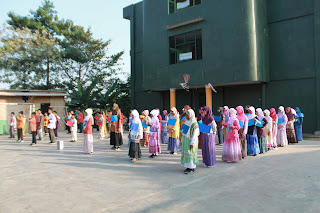Students, in order to ease you to study for the mid test, I give you a brief summary of the English subject material. Through this summary, I hope you are able to study and understand well. Good Luck!
- Husband
- Wife
- Grandmother
- Grandfather
- Mother
- Father
- Daughter
- Son
- Sister
- Brother
- Uncle
- Aunt
- Cousin
- Nephew (male)
- Niece (female)
Possessive
with Apostrophe (‘) s
Apostrophe can be used to show
possessions (kepunyaan).
For example:
- Ali’s wife :
istri Ali
- Umar’s brother : saudara laki-laki Umar
- My father’s daughter : anak perempuan Ayah saya
- Umi’s uncle : paman Umi
- Khalid’s grandfather : kakek Khalid
Jobs
Here are some kinds of jobs, the
responsibilities, and the workplaces:
JOB
|
WORKPLACE
|
RESPONSIBILITY
|
1.
a
teacher
|
at
school
|
teaches
students
|
2.
a
doctor
|
in
the hospital
|
treats
patients
|
3.
a
postman
|
in
the post office
|
delivers
letters
|
4.
a
policeman
|
in the police office /
police station
|
solves
crimes
|
5.
a
secretary
|
in
the office
|
types
letters
|
6.
a
civil servant
|
in
the government office
|
serves
people
|
7.
a
farmer
|
in
the field
|
grows
rice
|
8.
a
singer
|
in
the TV station
|
entertains
peopla
|
9.
a
waiter / a waitress
|
at
a restaurant
|
serves
food and drink
|
10.
a
steward /
a
stewardess
|
at
a plane
|
serves
passengers
|
Units
of Measurement
Units of measurement can be used to
show the quantities of uncountable things. Here are some examples of units of
measurement:
- a kilo of sugar : sekilo ...
- a bar of soap, a bar of chocolate : sebatang ...
- a bottle of shampoo, a bottle of milk : sebotol
- a can of cola, a can of milk : sekaleng
- a loaf of bread : sebalok roti
- a pack of coffee, a pack of noodle : sebungkus/sepak
- a carton of noodle, a carton of snack : sekardus
- a tube of toothpaste :
(bentuk seperti tabung/pipa)
- a bowl of porridge : semangkuk
- a plate of rice : sepiring
- a glass of juice : segelas
- a cup of tea : secangkir
- a jar of cookies, a jar of candies : setoples
- a slice of cake : seiris
- a piece of paper :
sepotong/sehelai
- a pair of shoes, a pair of glasses : sepasang
- a litre of cooking oil :
seliter
Nouns,
Adjectives, and Verbs
For example : a bag, a glass, a school, a classroom, a doctor, a farmer, a ruler, a car, etc.
Function : to modify/describe
nouns/pronouns (untuk menjelaskan atau memberi atribut pada kata benda atau
kata ganti).
For example : beautiful, cheap,
expensive, short, long, small, new, old, red, white, Indonesian, Malaysian,
wool, cloth, leather, empty, clean, dirty, round, rectangular, sharp, etc.
For example : have/has, am/is/are,
buy, do, go, use, give, get, make, etc.
Noun
Phrases (frasa benda)
Noun phrase is a combination of noun(s)
and adjective(s).
The pattern is : adjective + noun
For example : a new dictionary,
two sharp pencils, a box of long ruler, etc.
Descriptive
Text
Descriptive text functions to
describe a thing, a place or a person. It has two main parts:
- Identification : identifies a thing, place, or person that is described.
- Description(s) : describe(s) the parts, qualities or characteristics.
For example :
My
Bag
This is my bag. It is made of
leather. It is a big, strong and pretty bag. It has a long strap and four
pockets. Its color is brown.
The structures of the text:
- Title : My Bag
- Identification : This is my bag.
- Descriptions : It is made of leather. It is a big, strong
and pretty bag. It has a long strap and four pockets. Its color is brown.
Writing
a descriptive text
In a descriptive text, we can
describe a thing by writing its color, material, characteristics, and many
others. The following is an example of a descriptive text based on a particular
picture.
My Bicycle
This is my new bicycle. It is a strong bicycle. It color is blue and black. It is expensive. My parents gave it to me yesterday. I like my new bicycle very much.



